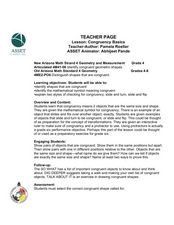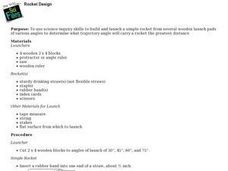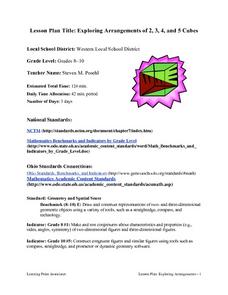Curated OER
Congruency Basics
Fourth graders investigate congruent shapes. For this congruency lesson, 4th graders explore examples of congruent shapes. Students determine how to check for congruency by sliding or flipping the shape.
Curated OER
Volcanoes: Piles of Fire
Students investigate how particle size affects the angle of a volcano's slope.
Curated OER
Rocket Design: Aerodynamics, Trajectories
High schoolers use science inquiry skills to build and launch a simple rocket, from several wooden launch pads of various angles, to determine what trajectory angle carry a rocket the greatest distance.
Curated OER
Making a Mountain Out of a Snow Hill: Skiing, Winter Sports, Economics, Business, Problem Solving
Learners explore how to select among choices of variables and analyze the cost-benefit ratio of their short and long term planning in a team activity as they consider the planning and operation of a ski slope.
Curated OER
Speed Is the Key
Students design and build a model downhill ski course that proves to be the fastest course at the Finish Line. They apply what they explore angles, slope, speed, and surface conditions to find the fastest course in the US.
Curated OER
Those Amazing Seaworld Animals
Students research the animals at SeaWorld and then relate the info they have found into various types of graphs; line, circle and bar. This lesson combines math and science nicely. They access a website imbedded in this plan to do their...
Curated OER
Polarization Of Light
Students discover that polarization filters block incoming light from passing through when filters are positioned perpendicularly to each other. They explore some of the uses of polarization filters within our society.
Curated OER
Inscribed Angles
Students analyze inscribed angles and intercepted arcs and explore the relationships between the two. They investigate the properties of angles, arcs, chords, tangents, and secants to solve problems involving circles.
Curated OER
STABLE ANGLES OF SLOPES
Students conduct an experiment using soil and shoeboxes to explore factors controlling and affecting the slope of a hillside. They analyze angles, surfaces, etc. to gain an understanding of instability of slopes.
Curated OER
Angles: Angles, Angles, Everywhere
Middle schoolers estimate and accurately measure the size of angles communicate with the appropriate geometric terms and symbols to describe and name angles, lines, line segments, rays
Curated OER
Mariner's Compass Quilts: New Directions
Students follow the steps of creating Mariner's Compass blocks using two different methods, freezer paper templates and paper foundations. Then they draft their own original full size block on freezer paper.
Curated OER
Create Your Own Family Crest
Students develop a design for their own family crest. Students make a large model crest for their family.
Curated OER
High School Mathematics Problems from Alaska: Azimuth and Arc Length
Students track the Azimuth sunrise and sunset over time by creating a chart.
Curated OER
Rearrange the Room
Second graders measure and grid their ideas for the new classroom floor plan. They create their own ideas for the classroom arrangement on grid paper. When they finish, they share their draft plan with their peers and with the teacher...
Curated OER
Our Class Record Book
Second graders, in groups, prepare a list of proposed record ideas for the class book.
Curated OER
Astronomy With a Stick
Young scholars find the altitude of the Sun at 10 A.M., at solar noon, and at 2 P.M. by measuring the height of the gnomon and the length of the shadow at each time. They record the measurements in their notebooks for later conversion.
Curated OER
Complex Color Wheels
Students design a color wheel which incorporates 12 colors, tints and shades of each color, black and white within a circle.
Curated OER
Can You Dig It?
Students investigate a fossil site and diagram a site map. They role play as paleontologists.
Curated OER
Columbian Contexts
Students explore geo-political and economic contexts for the European Renaissance journeys of exploration, including those of Columbus, create cartographic symbols, and add those symbols to a print-out of Ptolemy's map.
Curated OER
Spiders' Wheel
Students engage in a lesson which reinforces the concepts of clockwise and anti-clockwise rotation, while developing an understanding that angles are measured in degrees. They utilize a mathematics educational program to gain practice.
Curated OER
Exploring Arrangements of 2, 3, 4, and 5 Cubes
Learners construct models of various tricubes, tetracubes, and pentacubes that are possible, classify n-cubes into different groupings, and draw these figures on isometric dot paper giving true perspective to what they visualize.
Curated OER
Twisted Vision
Students explain polarization vision and why some animals have it while others do not. They examine the reasons why it would be helpful for marine organisms to have polarized light.
Curated OER
Beaches of the Delaware Estuary
Students examine estuaries in Delaware. They, in groups, gather samples of water to find organisms and identify them.
Curated OER
Toothpicks and Timber
Students problem-solve how to log five acres. Working in pairs, they construct models of logging sites before and after the trees are harvested. they paint their models and include other environmental details.
Other popular searches
- Circle Graph Protractor
- Using a Protractor
- Measuring Angles Protractors
- 360 Degrees Protractor
- Angle Measure Protractor
- Geometry Using a Protractor
- Using Protractors
- Protractor Postulate
- Protractor Worksheets
- How to Use a Protractor
- Compass and Protractors
- Protractor Lessons

























